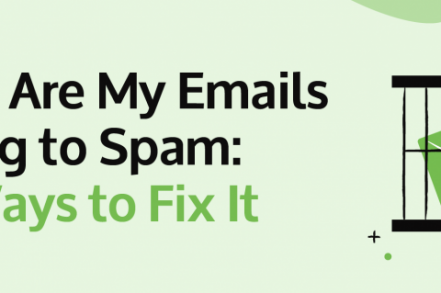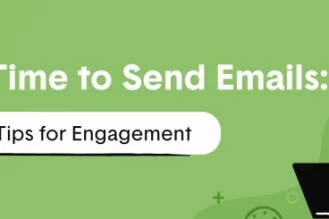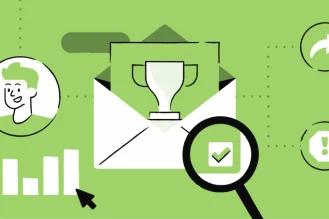Nearly one in five emails end up getting caught in spam filters — are you part of that statistic?
Whether you are conducting email marketing or sending mail to colleagues or friends, constantly wondering “Why are my emails going to spam?” can be frustrating. Today’s spam filters are complicated, and any number of seemingly-innocuous attachments, messaging, or even words themselves can send an email straight to spam.
In this article, we will detail what spam filters are, and ten ways you can adjust your messaging to end up in your recipient’s inbox.
What is a spam filter?
Spam filters are software programs that identify and filter unsolicited or harmful email messages before they reach a user’s inbox.
There are different types of spam filters on the market, but they all operate with the same purpose: to protect email users from scams and other attempts to access their personal information. Using a broad range of criteria such as scoring mechanisms, analyzing the content of the email, the reputation of the sender, and more, these filters ensure that an email inbox remains safe.
It’s important to note that not all filters operate with the same criteria — the Gmail filter will likely have different spam criteria than third-party software. That being said, there are best practices you can follow to ensure your messages don’t get sorted into spam.
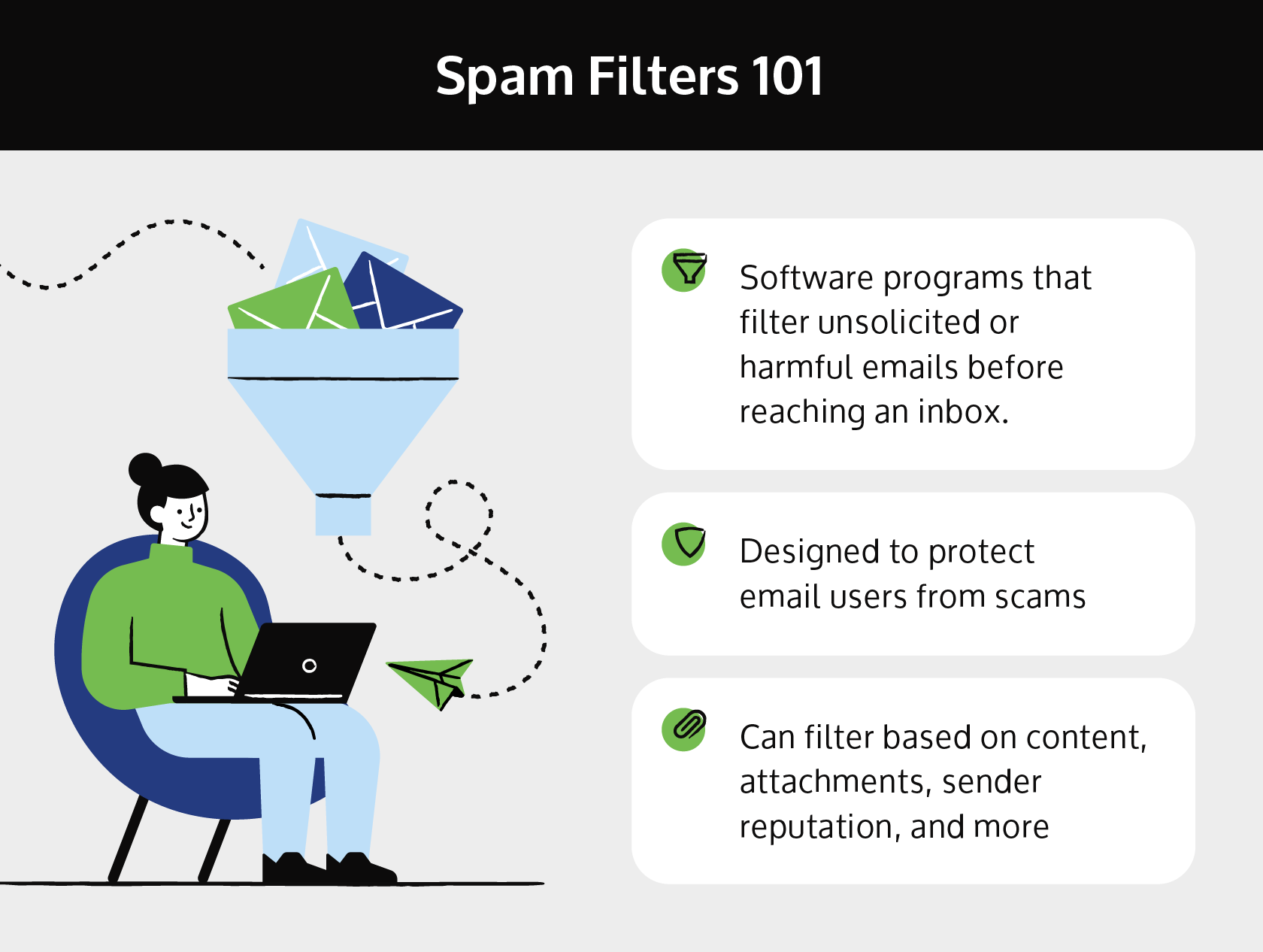
Why are my emails going to spam?
You’ve spent time and resources crafting the perfect email message — make sure that your recipients are receiving them. Here are ten reasons your emails may be going to spam, and ways to fix them.
1. You aren’t tracking your emails
How can you be sure that your emails are going unopened if you aren’t tracking them?
While tracking your emails won’t stop them from going to spam, monitoring the data behind open rates can be used to find a solution. For example, maybe a certain prospect pool is opening your emails at an abnormally low rate — in this case, they may be sending your emails to spam, and you should shift your outreach towards prospects that get more value from your communications.
With an email tracker like we offer at Right Inbox, you can see who opens and clicks your emails in Gmail, so you can perform more effective email outreach.
2. Your subject lines
Subject lines are typically the first thing the recipient sees, and email marketers need to toe the line between attention-grabbing and spammy.
Not enough persuasion in this crucial area could lead to the recipient passing up the message entirely. However, trying too hard with sensationalist claims, overdoing the caps lock and emojis, or being plain misleading is just as harmful — and either scenario is a one-way ticket to the trash bin or spam folder.
Some elements of a poor subject line include:
- Unprofessionalism: Adhere to proper grammar and punctuation when crafting subject lines. Save the caps lock, misspellings, and other elements for off-the-clock communication.
- Not meeting expectations: If you bait and switch by promising one thing in the subject line and delivering another in the body of the message, recipients will feel misled or angry. Make sure your message is consistent.
- Being too personal: There’s a difference between personalizing your emails and being overly personal. Subject lines such as “Is my phone at your house?” could cause recipients to think they know the sender — and be confused when they realize they don’t.
How to fix:
Craft attention-grabbing subject lines, but be honest and useful. Don’t mislead recipients with your messaging, and always adhere to professionalism. Nothing screams spam more than caps lock or sensationalist claims.
3. Subscriber inactivity
A misstep plaguing email marketers is thinking that a mailing list should always be growing — but every once in a while, there comes time to prune a subscriber base.
Consumers have fluid interests and circumstances. What they were interested in a few months ago may not align with their current goals. They may have been locked out of their email account, or perhaps they just don’t open your emails anymore. Whatever the case may be, if a subscriber isn’t interacting with your emails over a long period of time, they shouldn’t continue to receive them.
Continuously sending emails to the wrong consumers can lead your messaging to the spam list.
How to fix:
Take time every few months to assess your subscribers. Determine those that are interacting with your content, and those that aren’t — and remove the latter from your email list. Remember, quality over quantity.
4. Subscribers can’t opt out
Making it easy for subscribers to opt out of future messaging isn’t just a best practice — it’s the law. According to the CAN-SPAM Act, your emails must include a “clear and conspicuous explanation” for recipients to opt-out, and those requests must be honored within ten business days.
Besides regulatory reasons, having a clear way for subscribers to stop receiving messaging positions your business as a trustworthy entity. When paired with honest content, consumers will gain a favorable impression of your organization.
The alternative, however, results in frustrated subscribers — many of whom will add your email address to their spam filter in a heartbeat.
How to fix:
Ensure that saying goodbye is as seamless as saying hello. Having a clear opt-out policy will prevent your emails from being marked as spam — this may even open the door for re-subscription down the line.
5. You’re not asking to be whitelisted
When a subscriber whitelists you, your business is added to their contacts or email address list. This ensures your messages stay far away from the spam filter, but the problem is many companies fail to implement this important step.
Asking to be whitelisted helps twofold: each subscriber will be guaranteed to receive your emails until they opt out, and the more people that whitelist your address, the more reputable you will be in the eyes of spam filters.
How to fix:
The fix for this situation is simple: ask your subscribers to whitelist you. This is most effective in a welcome email, or the first message you send to them. Asking them when they are most excited to receive your message will increase effectiveness and success rates.
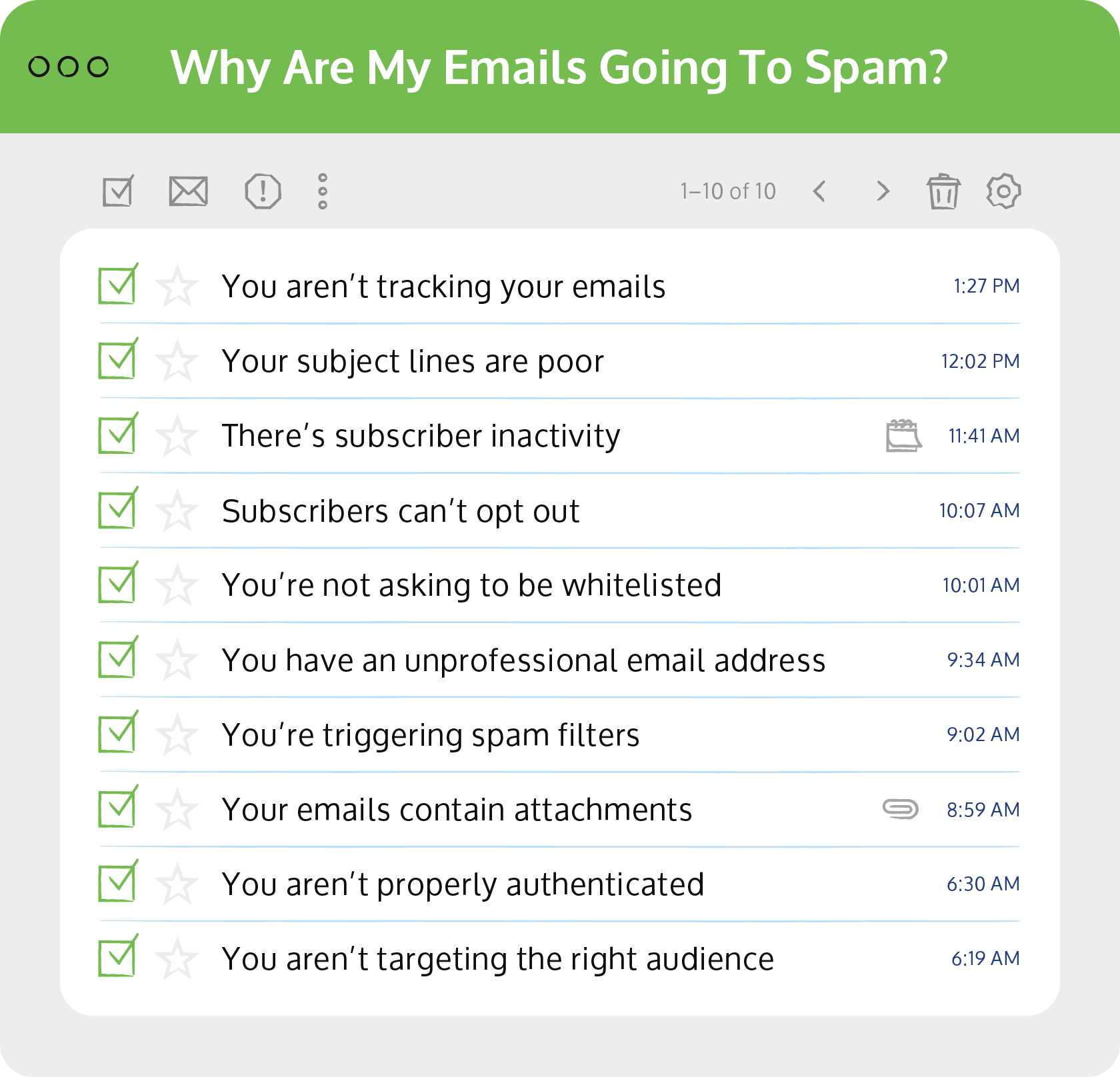
6. Your email address is not professional
When sending business-related emails, a professional email address is a must. Nearly half of all subscribers read an email because of who it’s from — so if they don’t recognize or respect the “from” address, it’s a coin flip if they’ll open the email or not.
In addition to professionalism, accurate “from” information is a legal requirement. Based on the CAN-SPAM Act referenced above, it’s also necessary that email addresses be accurate and not misleading.
Unprofessional email addresses will send your emails to the spam list at best, and result in legal hot water at worst.
How to fix:
Make sure your “from” tag is honest, accurate, and professional.
For example, john@gmail.com looks unprofessional and is likely to head to the trash or spam filter. John@johnscompany.com, on the other hand, will warrant a more receptive response.
Additionally, in certain situations, it may be wise to send emails from relevant accounts. If a subscriber has signed up for a marketing newsletter, it could be a good idea to send those emails from the head of marketing at your business.
7. You’re triggering spam filters
Your message will never reach your recipients if it gets stopped in its tracks because of the copy. Spam filters are increasingly sophisticated and can be triggered by a few common reasons.
First, your message may flag a spam filter if you use too many trigger words or phrases. These can be as innocuous as “sale” or “click here”, and if you are using them in abundance, your message may be classified as spam. A few examples of trigger words and phrases include:
- Free
- Cashback
- Easy money
- Full refund
- More money
- Guarantee
- Order now
- Anything in ALL CAPS
Additionally, your emails may flag a spam filter if your address has a poor sender reputation. If many different users flag your messages as spam, filters may label your address as a spam account and automatically block your messages from new users.
How to fix:
While it’s not possible to craft a message without the use of some trigger words, make sure you are using them sparingly. Ensure your content is honest and useful, and you’ll naturally avoid spam filters and recipients labeling your address as spam.
8. Using attachments
You may think it’s innocent enough to send an email with attachments to your subscribers — perhaps a recent newsletter or document you would like to highlight to your audience. The problem is that sending attachments in emails is a massive red flag that triggers spam filters.
Spam accounts and other nefarious senders often embed viruses into email attachments in the form of zip files or pdfs. If you are sending these types of files in email messages, your account will be flagged as spam no matter your intention.
How to fix:
Don’t send attachments in emails. If there is a piece of content you’d like to highlight, include a link to your website so readers can go there directly. Alternatively, downloading a piece of content to a cloud service such as Google Drive, and then including that link in the message, can act as an acceptable intermediary.
9. You aren’t properly authenticated
In today’s tech landscape, scammers can imitate nearly any email address — even yours. As a response, many spam filters immediately flag email addresses that aren’t authenticated, regardless of the content.
To ensure your email address is properly authenticated, start with the following certifications:
- DomainKeys Identified Mail (DKIM): An email security standard that verifies the source of the email message, and ensures it hasn’t been altered or tampered with in transit.
- Sender Policy Framework (SPF): An email authentication method that helps to protect your account from being compromised, and can prevent your outgoing messages from being labeled as spam.
- DMARC: Another email authentication process that helps to prevent spam by preventing the sending or receiving of emails that are not from a trusted source.
How to fix:
Make sure your email address is authenticated with the methods highlighted above. While it may be tedious to set up, doing so will ensure your emails don’t end up in the spam folder.
10. You aren’t targeting the right audience
You could be crafting the most comprehensive and useful emails possible, but if you’re sending them to the wrong prospects, all of that effort will be wasted.
If your emails are suffering from low engagement, that could indicate your email list is filled with the wrong prospects. To compound the issue, if many of these individuals are not opening your emails or sending your address to spam, that may flag spam filters in the future.
How to fix:
While it may be tempting to focus solely on growth, make sure you are targeting the right prospects with your outreach efforts. Whether you are getting email addresses from lead magnets, social media, or directly from your website, ensure your messaging is consistent so these prospects know exactly what they are signing up for. This will build a relevant and engaged email audience.
Track your emails with Right Inbox
It can be disheartening to always wonder “Why are my emails going to spam?”. All the time and effort spent crafting a perfect email can be wasted in a split second if you violate any of the common spam triggers as outlined above. We hope you found value in our tips, and that you are one step closer to having your messaging land in the inbox.
That being said, the first step to knowing if your emails are going to spam is knowing if they are being opened. With an email tracker like we offer at Right Inbox, you can see who opens and clicks your emails in Gmail, so you can perform more effective email outreach.
Track emails, email reminders & templates in Gmail for free
Upgrade Gmail with the features it’s missing
Add to Gmail